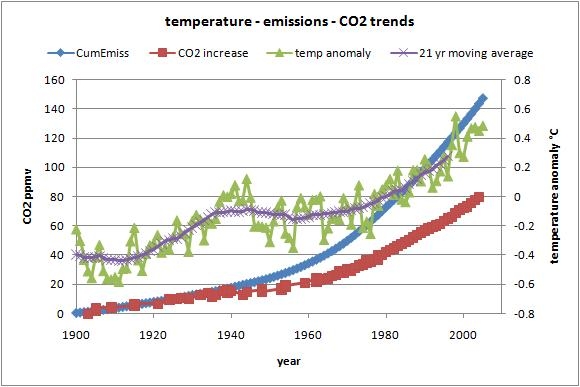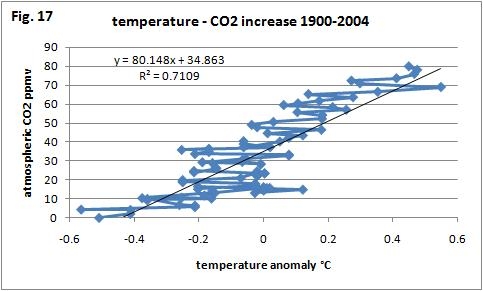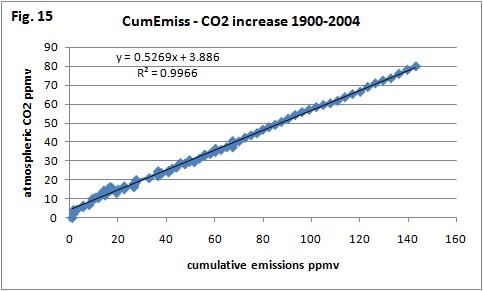After yesterday’s post about manmade vs. natural sources of CO2, I received the following e-mail from Ferdinand Engelbeen. I’ve reproduced that e-mail below, and made a couple of comments (also in italics)….I’m at a conference, so I posted this quickly…sorry for any typos… and thanks to Ferdinand for taking the time to respond. – Roy
Dear Dr. Spencer,
I have reacted a few times via Anthony Watts’ weblog on your different thoughts about the origin of the increase of CO2 in the atmosphere. Regardless if that is man made or not, I think we agree that the influence of the increase itself on temperature/climate is limited, if observable at all. But we disagree about the origin of the increase. I am pretty sure that the increase is man-made and have made a comprehensive page to show all the arguments to that at:
http://www.ferdinand-engelbeen.be/klimaat/co2_measurements.html
Thus here follows my critique on your blog page:
Besides the mass balance (which excludes any net natural addition as long as the increase in the atmosphere per year is less than the emissions), there are two essential points:
The d13C reduction:
Indeed it is not directly possible to make a distinction between 13C depleted fossil fuel burning and 13C depleted vegetation decay. The fingerprint of d13C changes by vegetation over the seasons is much larger than from fossil fuel burning (~60 GtC vs. 8 GtC, with about the same average d13C level). But vegetation changes are two-way, while fossil fuel burning is one-way addition. Thus the absolute height of the seasonal variation is not important, only the difference at the end of the year with the previous year is important for the year-by-year and multiyear trend. (Yes…I was making no claim regarding the seasonal cycle as being contributed to by mankind…although a change from one year to the next could still be due to a small imbalance between the huge natural sources and sinks. – Roy)
To know if the biosphere as a whole (sea algues + vegetation + soil bacteria) is a net absorber or emitter, we have a nice distinction between the two opposing actions of growth and decay: oxygen use. That can be used to determine the difference. The type of fuels used are known with reasonable accuracy, and thus their oxygen use when burned is known with reasonable accuracy too. Now since about 1990, oxygen measurements have sufficient accuracy to see the very small changes that fossil fuel use cause and the deficit/addition that the biosphere growth/decay adds to the fossil fuel use of oxygen. This revealed that since about 1990 the biosphere is a net source of oxygen and thus a net sink for CO2 (and thus of preferentially 12CO2), enriching the atmosphere with 13CO2. The biosphere as a whole thus is a net source of 13CO2 and can’t be the origin of the decreasing d13C levels. The oxygen use and d13C changes are used to estimate the partitioning of CO2 sequestering between land biosphere and oceans:
See: http://www.sciencemag.org/cgi/content/abstract/287/5462/2467
and: http://www.bowdoin.edu/~mbattle/papers_posters_and_talks/BenderGBC2005.pdf (up to 2002) (But isn’t this just one component of the total budget? You are talking specifically about what happens to the extra manmade CO2, and how it affects O2 and C13…I’m talking about some sort of oceanic, temperature dependent source…say a decrease in phytoplankton growth associated with warming.-Roy)
Other sources of low d13C don’t exist in fast/large quantities: (deep) oceans, calcite deposits/weathering, volcanic degassing,… in general have high(er) d13C levels (around zero per mil) compared to the atmosphere (-8 per mil). Thus the human use of low d13C (and zero d14C) fossil fuels is the sole cause of decreasing d13C levels. (But Behrenfeld, 2006 showed huge Climate Driven Trends in Contemporary Ocean Productivity…wouldn’t these have a substantial depleted C13 signature? – Roy)
d13C levels decrease as well as in the atmosphere as in the upper oceans in line with the use of fossil fuels: relative stable from 600 to 150 years ago and starting to decrease faster and faster in the past 150 years, see e.g. the decrease of d13C in coralline sponges and ice cores/firn/atmosphere at:
http://www.ferdinand-engelbeen.be/klimaat/klim_img/sponges.gif
Although fossil fuel burning is the sole cause of the d13C decrease, the result is less (about 1/3rd) of what can be expected from the burning of fossil fuels, if every molecule remained in the atmosphere. But that is not the case, as near 20% per year of the atmospheric CO2 is exchanged with vegetation (less influence, as most comes back next season), upper oceans (idem) and deep oceans (that is important, as that disappears in a large mass). With an exchange of about 40 GtC from the deep oceans, the calculated reduction of d13C fits most of the (recent) trend of d13C in the atmosphere…
Further: the sentence:
“And since most of the cycling of CO2 between the ocean, land, and atmosphere is due to biological processes, this alone does not make a decreasing C13/C12 ratio a unique marker of an anthropogenic source.”
Is not accurate, as most of the seasonal cycling between the oceans and atmosphere (~90 GtC) is abiogenic and a matter of solubility of CO2 at different temperatures and salt/bi/carbonate concentrations and pH of the ocean surface layer.
Feely e.a. has made several interesting pages on that: http://www.pmel.noaa.gov/pubs/outstand/feel2331/exchange.shtml (I’m surprised at this claim…I thought the seasonal cycle is dominated by Northern Hemispheric vegetation growing and dying each year? Indeed, my first figure from yesterday’s post clearly shows the seasonal cycle has the largest dC13 signature…? – Roy)
Thus the main conclusion is that the d13C trend is not caused by the biosphere and strengthens the case for a human origin.
The temperature-CO2 connection:
I have had several discussions about this subject. The first point is that most of the people look at too short time intervals. We are interested in the (none) role of increased CO2 accumulation in the atmosphere on climate. Thus let us start with the trend of accumulations: temperature vs. accumulated emissions and accumulation in the atmosphere:
Well the temperature trend shows distinct periods with flat to negative trends (1900-1910, 1945-1975 and 1998-current) and upgoing trends (1910-1945, 1975-1998). There is some correlation with CO2 levels. As good as for temperature caused by CO2 levels as the “warmers” assure us, as the opposite way, but not really convincing. On the other hand the accumulation in the atmosphere is a near perfect replica of the accumulated emissions only at a lower level: 55% of the emissions on the whole 100+ years trend or any part of a few years long of that trend. One can see that more clear in the two correlation trends:
A huge short term temperature change of halve the scale has an influence of only a few ppmv/°C, while the “long” term temperature change should have an influence of 80 ppmv/°C? Seems rather impossible, especially when compared to the Vostok (and other ice cores) record, where a relative constant ratio of 8 ppmv/°C is recorded over the full past 420,000 years.
Compare that to the emissions-atmospheric accumulation correlation trend:
A near perfect fit…
Thus what you see if you look at the year-by-year accumulation rate is a mix of a trend (at about 55% of the emission, or about 1.5 ppmv/yr nowadays) and the direct, short-term influence of (mainly) temperature.
Your formula for the direct temperature influence (both detrended) is:
dCO2/dt = 1.71 ppmv/yr/°C
but there is a problem with this. The detrended plot for dCO2/dt should be around zero, but the plot shows an average of 1.24 ppmv/yr, which is attributed to the temperature changes, thus is not really detrended. And even with a negative temperature anomaly, there still is a continuous increase of CO2, which ends at about -0.7°C temperature anomaly.
The next, more important problem is that the formula has no time limit. Even with a constant temperature, the CO2 increase is indefinitely. If that is applied to the past, then the ice ages should show zero CO2 and the interglacials several thousands of ppmvs… Even on the more nearby past: the LIA lasted several decades, but only shows a decrease of about 8 ppmv/°C, near identical to the long term ratio seen in the Vostok ice core. While the current variability around the trend is in the order of 3 ppmv/°C. That is a lot different from an unlimited trend of 1.71 ppmv/yr/°C.
If we look again at the graph of the temperature and the accumulation of the atmosphere, then according to your interpretation, the CO2 levels would be decreasing increasing 1900-1920, increasing increasing 1920-1940, constant increasing 1940-1975, increasing increasing 1975-1998 and constant/declining increasing 1998-current. Although resembling, not really what is seen in the trends. Still the trend from accumulated emissions is far superior…
My formula looks more like:
dCO2/dt = 3 * dT + 0.55 * d(emissions)
where dCO2/dt holds for any time period (past or present), 3*dT is for short term changes and may expand to 8*dT for long term sustained changes and dT is for any time period, but always the difference over the full period.
Pieter Tans has a better fit than me by including precipitation. See:
http://esrl.noaa.gov/gmd/co2conference/pdfs/tans.pdf
Last but not least, the mass balance is a little difficult to explain with your attribution of a large part of the increase to temperature. As long as no matter disappears to space we have according to your attribution over the past 50 years:
attributed to temperature: +52 ppmv
added by humans: +110 ppmv
observed: +60 ppmv
to be removed by unknown (natural) sinks: 102 ppmv
Thus some natural sinks must remove more CO2 from the atmosphere than the increase of CO2 which is attributed to the temperature increase…
Moreover, as the oceans are the main source of extra CO2 by increasing temperatures, according to this scheme, the sole fast sink remaining is the biosphere. Thus the terrestrial biosphere should have removed 102 ppmv in 50 years, which means the equivalent of about 33% of the total terrestrial vegetation (see http://earthobservatory.nasa.gov/Features/CarbonCycle/Images/carbon_cycle_diagram.jpg )… That in times of disappearing tropical forests seems rather unlikely…
That is the kernel of my objections…
Sincerely,
Ferdinand Engelbeen
retired engineer process automation

 Home/Blog
Home/Blog






